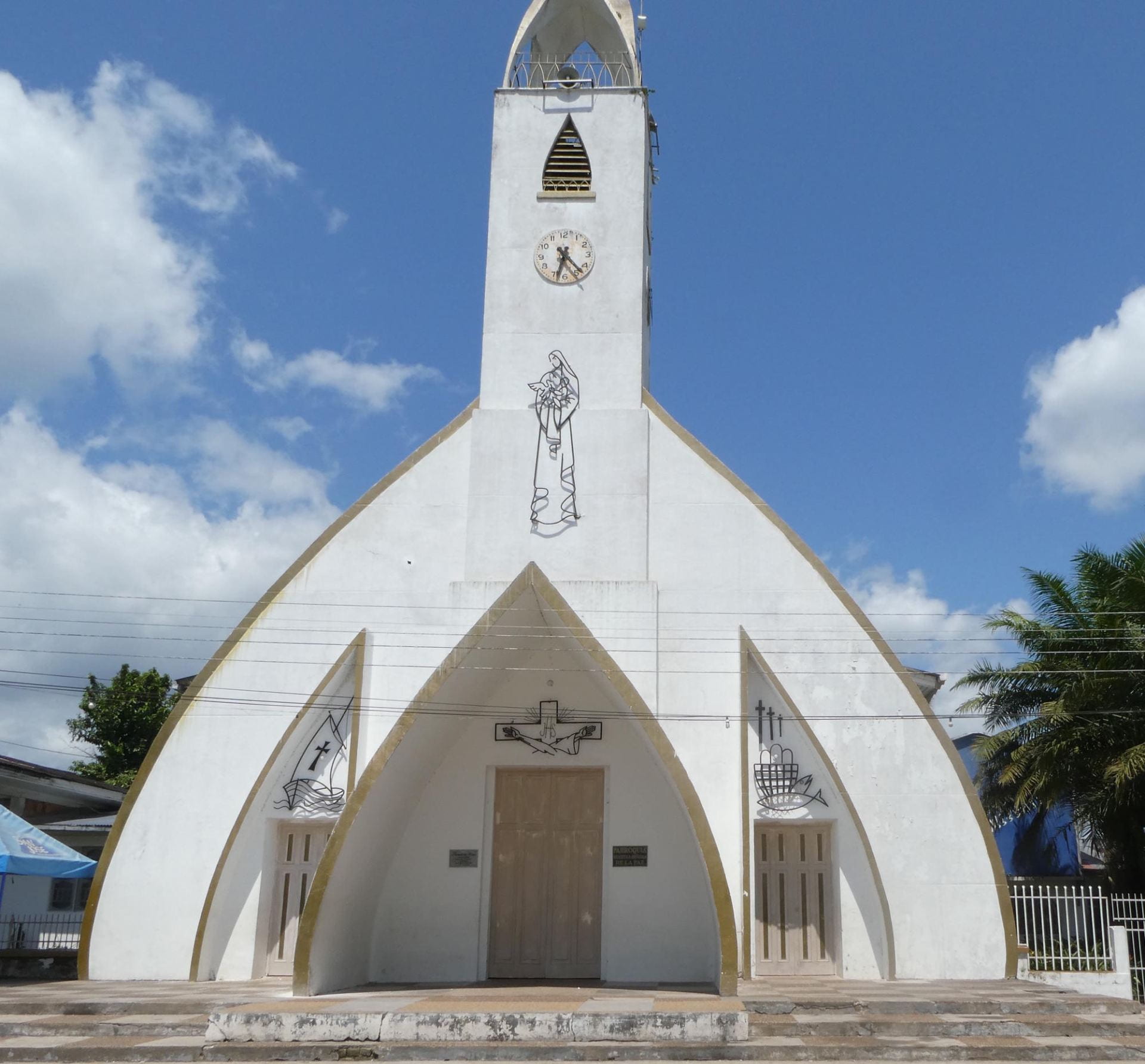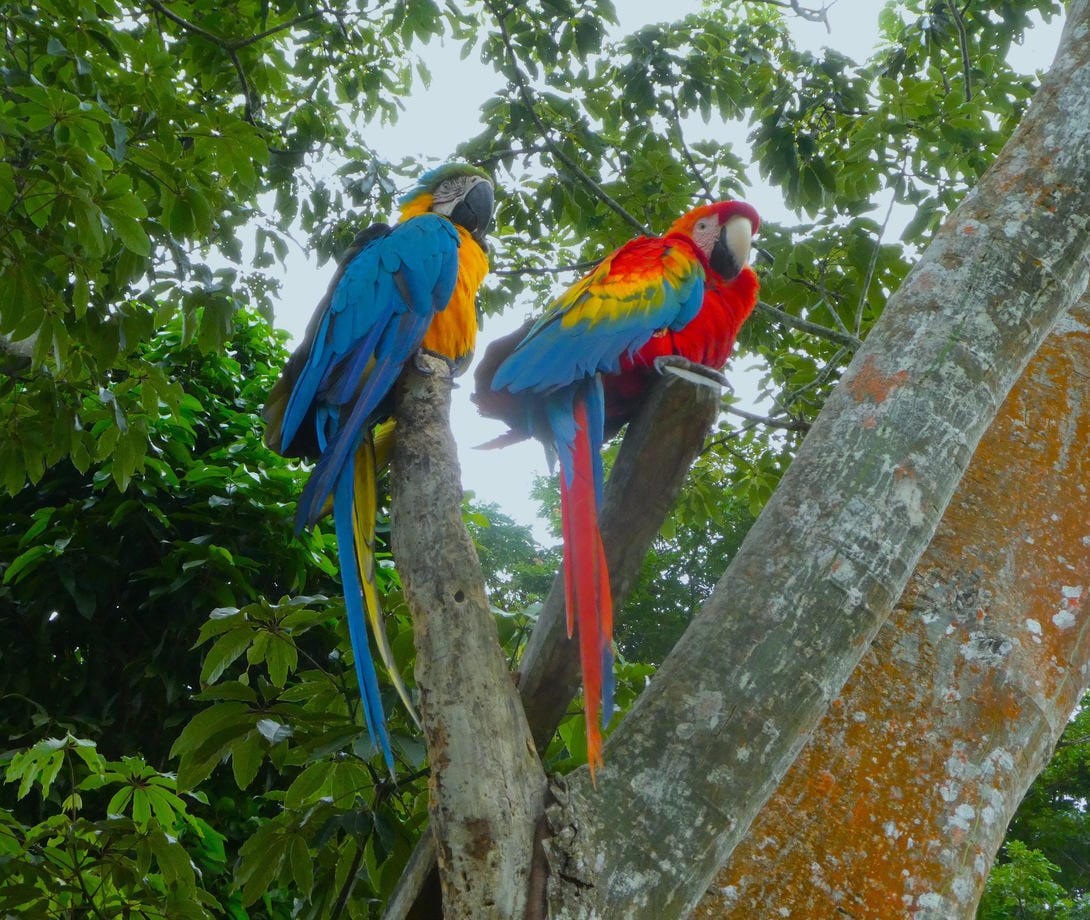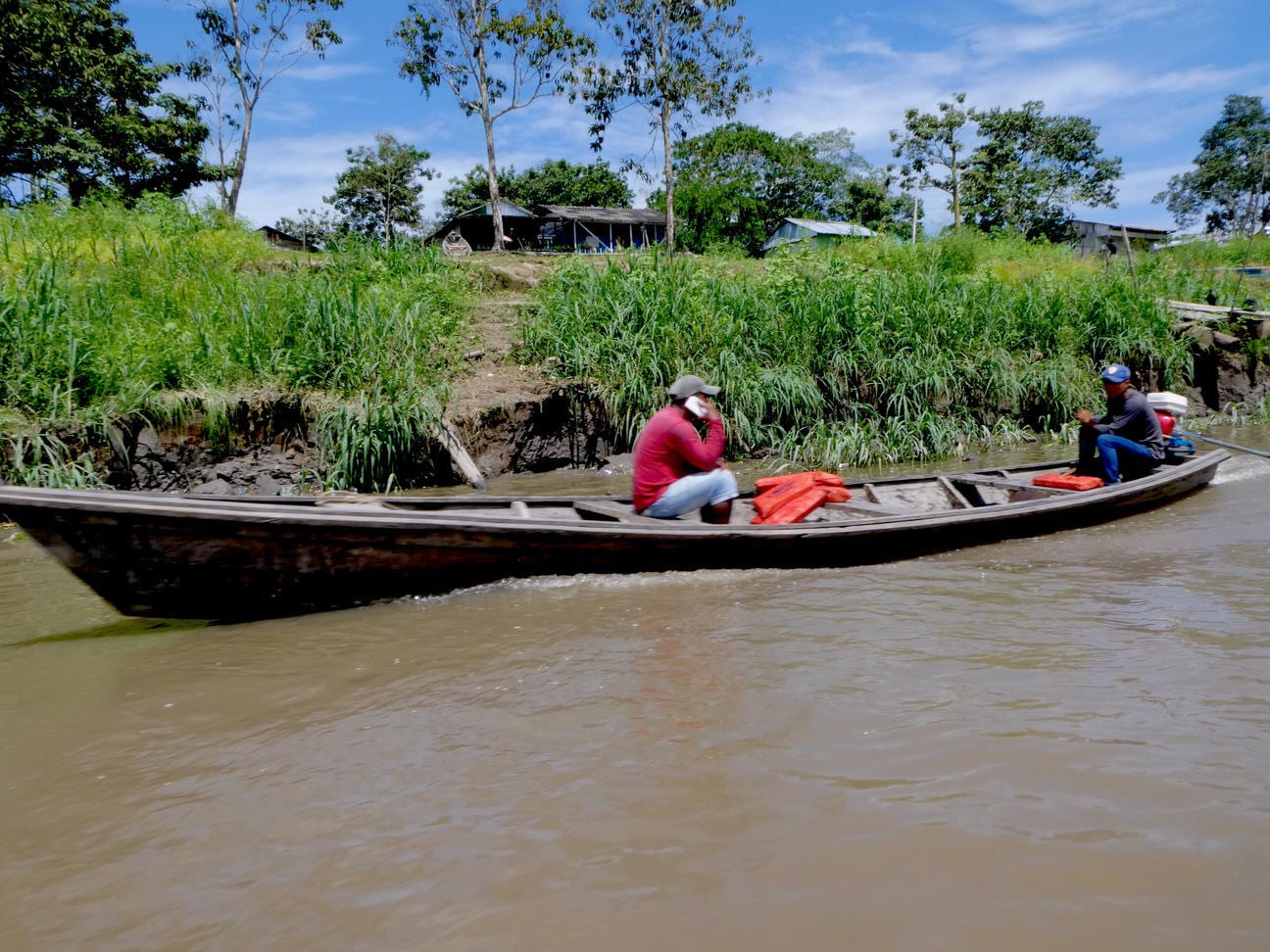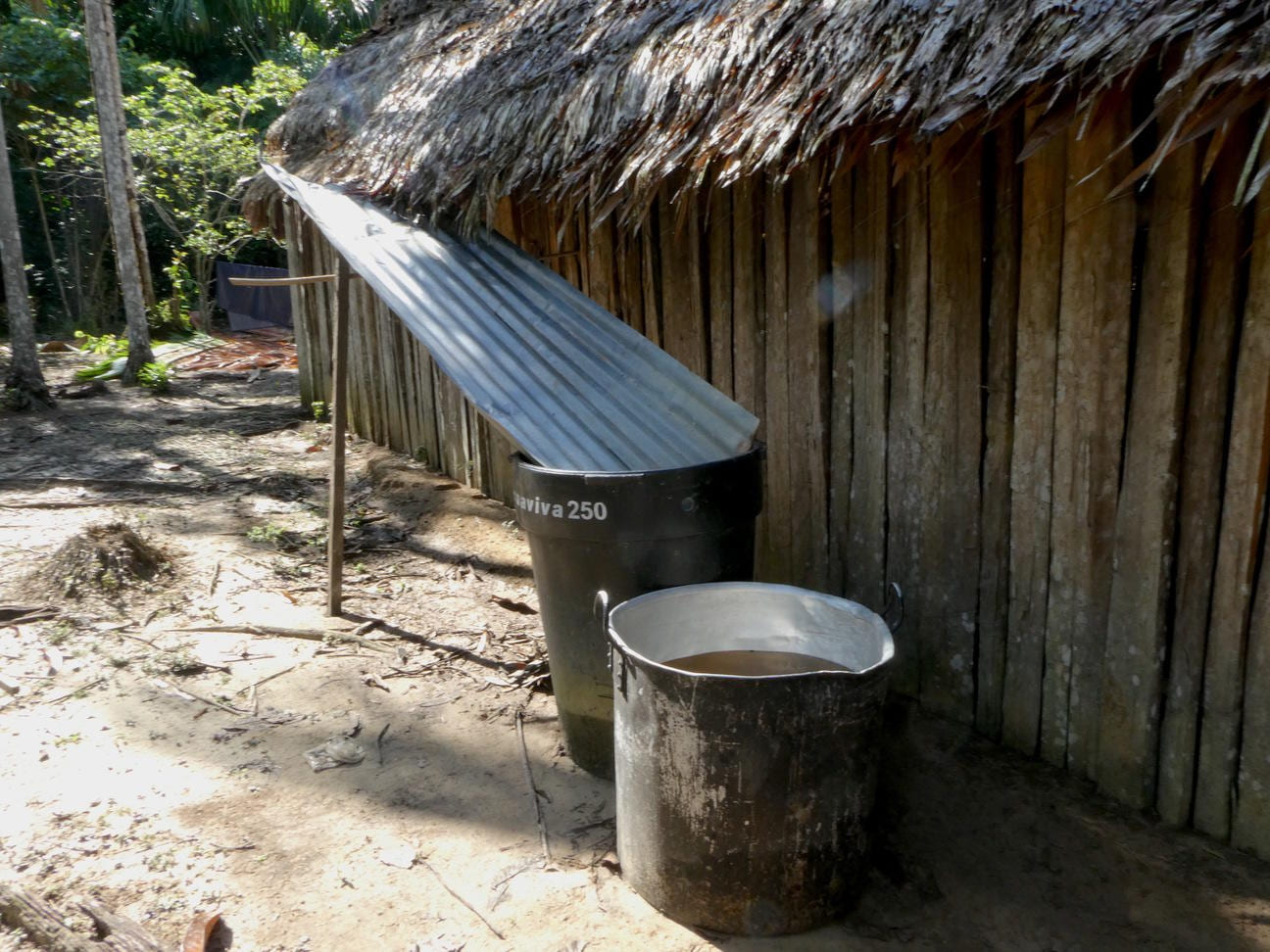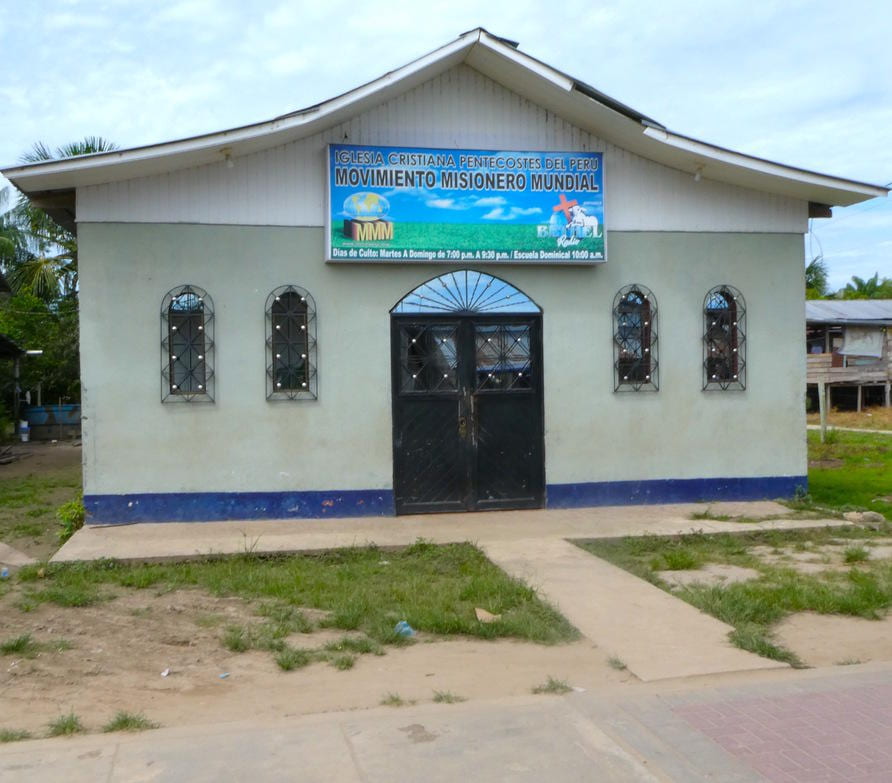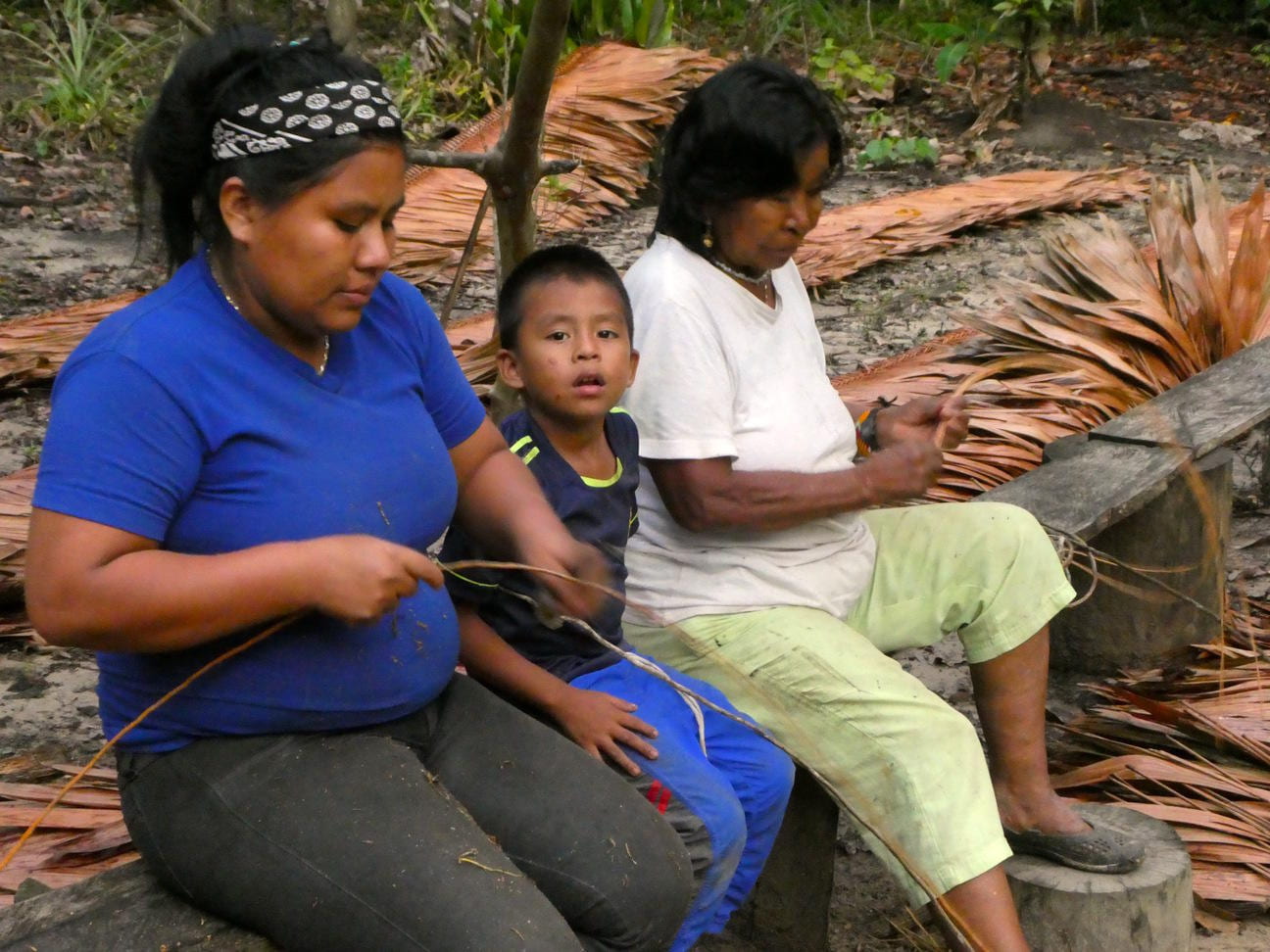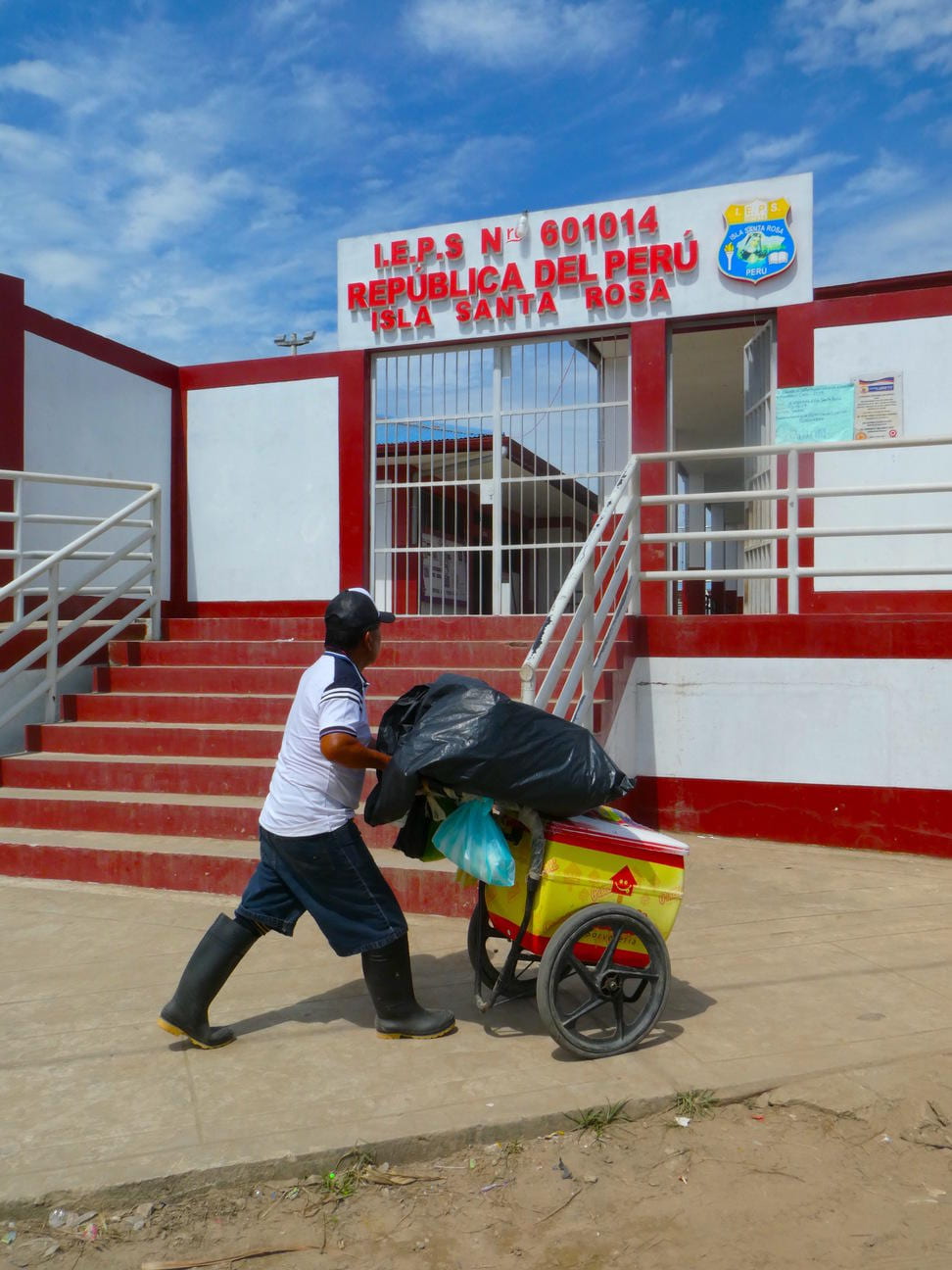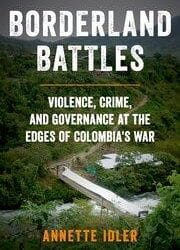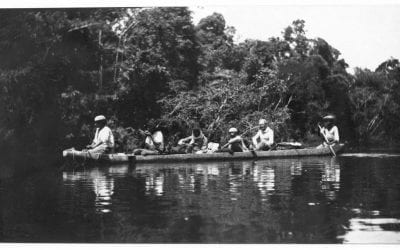The Catholic Church and the Souls of the Amazon
Photos by Mary Jo McConahay
From the Colombian Amazon town of Leticia, a visitor reaches Brazil or Peru in minutes by foot or canoe. Three outposts here – the towns of Leticia (pop: 48,000) and Tabatinga, Brazil (pop: 62,000), and the island of Santa Rosa, Peru (pop: 2,500) – and their surrounding territories—make up a bustling, shared zona fronteriza of Amazonia, a commercial and administrative zone. But the sense of the vast jungle is never far away. At twilight, a conversation at the residence of Capuchin fathers next door to Leticia’s small Catholic cathedral, Our Lady of Peace, must be held at shouting volume to be heard over the din of thousands of jungle parakeets descending upon trees across the street.
A huge banner hung high outside the residence invokes the 2015 encyclical of Pope Francis, Laudato Si, with an exhortation in Spanish, “Amazonas SOS – Called to make changes in style of life, of production and consumption.”
The Catholic Church is paying particular attention to Amazonia today, both for the sake of the souls who live here and for saving the wild nature of the world’s largest tropical rainforest. After two years of preparation and consultations with residents, 185 bishops met in Rome late last year in an ecclesiastical council of major importance. Some 87,000 people are said to have taken part in the preparatory meetings. The Pan-Amazonian Synod was an effort to shine a light on the region and give voice to those who are resisting deforestation, industrial mining and other ravages. Given the global importance of the Church, with 1.3 billion members worldwide, such attention is certain to have influence beyond the pews.
The indigenous of the Amazon are especially important in the eyes of the Church. Of some 400 tribes, some are nearing extinction (fewer than 500 people), and the ranks of others number in the thousands. They make up only about 12 percent of Amazonia’s estimated population of 30 million, but they weigh heavy on the fate of the basin that stretches across eight countries. Indigenous people have the deepest roots with the longest presence in the rainforest, arguably know it best, and legally control demarcated land or live within protected land far out of proportion to their numbers. Pope Francis, who emphasizes above all the pastoral aspect of the Church—accompaniment of God’s people—is also deeply concerned about disappearance of the rainforest; native peoples, he believes, are most capable of preserving it.
“They are not merely one minority among others, but should be the principal dialogue partners, especially when large projects affecting their land are proposed,” says the Laudato Sí encyclical, which is studied in parishes all over the world. For the indigenous, the pope wrote, “Land is not a commodity but rather a gift from God and from their ancestors who rest there, a sacred space with which they need to interact if they are to maintain their identify and values. When they remain on their land, they themselves care for it best.”
The Church’s new and notable Amazon outreach is an the influence of Pope Francis, the first Latin American pope, an Argentine elected in 2013. For Francis, environmental protection is one of the key moral issues of our day—global warming and destruction of the natural world affect the poor and marginalized first. Strengthening the Church in the Amazon is seen as a way of supporting residents against those who would come in to pilfer or destroy its riches.
“How to attend to the people without priests?” asked Rev. Rodolfo Piñero, a member of the Capuchin Missionaries in Leticia. Clergy are so widely dispersed throughout the Amazon region that some Catholics see a priest only once a year. Piñero says a local solution emerged “from necessity;” he calls it ‘integration of forces,” service not according to religious order or country but joint regional work by teams. In the fronterizo zone, that means teams composed of Jesuits, the vicariate, the Capuchins, the Hermanas Lauras (the Missionary Sisters of the Immaculate Virgin Mary and St. Catherine of Siena, founded by Colombian St. Laura Montoya) and many, many lay people.
“For the indigenous, there are no borders,” Piñero said. Ticuna Indians, for instance, live in Brazil, Colombia and Peru, visiting family or traveling for other reasons without care for national lines. “For them these are not separate places, and we are the same way, a zone of family.”
Piñero said the regional “integration of forces” idea was placed on the synod agenda as an example for discussion for other parts of the Amazon. Also on the Rome agenda was a controversial proposal to reach more Amazonian Catholics by ordaining mature married men, preferably indigenous, who are already serving as deacons; conservatives consider the proposal a challenge to the 900-year-old tradition of Roman Catholic clerical celibacy. Traditionalists also bridled at the synod idea of ordaining women as deacons, believing it could lead to more calls for female priests. Pope Francis will judge which proposals from the bishops’ meeting will be applied to the Amazon.
- Bathing water is collected from rain.
Whatever the future of the Roman Catholic Church in Amazonia, it faces mistrust for sins of the past. Priests and nuns historically protected the indigenous from egregious authorities and greedy private businesses, interceding for them. But they did so paternalistically, not in partnership with the indigenous as equals, according to educator Marco Fidel Vargas, sub-director of the Jesuit research institute CINEP in Bogotá. The church was part of “colonization and a patriarchal past,” he said, but now “must enter into a cultural dialogue” with the indigenous.
Missionaries often brought the brightest young people from the jungle to internados, boarding schools where the students satisfied a thirst for knowledge, but were also separated from their traditions. Some evangelizers branded customs such as honoring the elements, or honoring animals with whom the indigenous shared the forest, as diabolical. Many youngsters lost facility in their native tongues.
The Church was more present than the state in the rainforest, and also ran schools under contract from the state. The 1991 Colombian constitution recognized the right of indigenous to mandate how their children are educated, including in bilingual classes. Since then the number of schools “contracted” to Catholic religious groups has dropped; schools where the indigenous live have risen in number, although Colombian Amazon students remain among the lowest achieving (and worst funded) of the country. In some places, historically, had there been no church, there would have been no formal education. Nevertheless, said Vargas. “The church must reflect on this period of its past.”
The voice of fundamentalist protestant evangelical churches, representing some 22 percent of Brazilians, is largely absent from the concern over rainforest destruction that comes from Catholics. Evangelical churches are growing in the Amazon, where newcomers looking for work often join in their search for community and Christian worship; because Catholic Masses require an ordained priest, Catholic churches are rarer. On the two-block-long main street of the Peruvian Amazon island of Santa Rosa, for instance, a 15-minute boat ride from Leticia, there are three evangelical churches, but no Catholic Church.
President Jair Bolsonaro of Brazil, which has the largest extent of Amazonia within its borders, was elected in 2018 with massive evangelical support; he has said he wants to transform the Brazilian Amazon into an economic engine for the country, erasing indigenous reserves and opening the rainforest to farming, mining and timber industries, and he impugns the veracity of government scientists who report the fast rate at which that the rainforest is disappearing. During the record-breaking Amazonian conflagration of August, 2019, when more than 40,000 fires blackened the skies and toxic smoke reached São Paulo, 2,000 miles away, Catholic bishops demanded urgent action “crucial for the ecological balance of the planet.” While small groups of evangelicals reportedly joined street demonstrations against the destruction, no word or witness came from the major evangelical bodies, such as the Universal Church of the Kingdom and Assembly of God. In the municipality of Cocoal (pop: 85,000), located in Rondônia, the Brazilian Amazon’s most deforested state, Assembly of God pastor Leonardo Cortez told the ecumenical Religion News Service that the environmental crisis was manufactured by people with political motives. Activists, said Cortez, “don’t understand that we take from the Earth a great part of our livelihood and of the commodities Brazil exports.”
- Evangelical Church in Santa Rosa, Peru.
- Bianca, Axel and Isabel making a basket.
Catholicism and Indigenous Cosmovision: “No Contradiction”
Three hours hike from the nearest road out of Leticia, I trekked with a native guide through a corner of the Colombian jungle still soaked from hard rain. The mud sucked at my boots, and once, I fell flat on my back, chagrinned but protected from noteworthy injury by a patch of leafy jungle floor. As gray light broke, the forest opened upon a chacra, a plot of planted land that signaled someone lived nearby. There were mint, basil, yucca, coca plants, a yellow bloom called flower of the dead (for skin infections), a spray of palm-like leaves low to the ground called limonata (for colds and flu), and a big-leafed plant sprouting a giant pineapple.
Soon we came upon a thatched house three stories high at its peak, its magnificent conical roof made of palm leaves. Inside, the chief of this maloca, as the traditional house is called, rose from a packed dirt floor, lined with palm leaves that he was weaving into long, green strips for roof repair.
He was slim, dressed in cotton pants and shirt, wearing sandals, with a smiling face but authoritative air. “Welcome. Go change those wet clothes,” said the Huitoto tribe elder, Warrior of the Jungle, baptized William (“just William”), age 74.
Two hearths burned on opposite sides of the house, which measured sixty paces wide. At one fire, William’s wife, Isabel, of the Mura tribe, was smoking fresh-caught fish; at the other, their daughter Bianca stirred a pot of chocolate for her 7-year old son, Axel. Light slanted through thin spaces in the walls of sticks and wooden boards. There was no electricity.
This was a contemporary Catholic indigenous Amazonian family that nevertheless keeps to traditional customs — just the kind of family, along with economically poor non-natives — that the Amazonian synod aimed to serve. Among its traditions: four sturdy columns that squared the center of the house and honored the jungle, animals, water and the universe.
“We are indigenous people, but we are of a new generation,” William said later. “The world has changed a lot. The new indigenous have technology. Children are born with a more forward-looking mentality. Why? Because the world is turning very fast.”
A wooden trough and a heavy angular beater stood ready to smash yucca. Strainers and graters braided of fiber made from forest plants, used to prepare food, hung from a rafter. A tube of gleaming wood and a pole stuck in the top was there to pound roasted coca leaves into powder. William has a permit to grow the plants I saw in the chakra, for traditional use.
Unlike many families in the region, William’s family lived within a few hours walk from Leticia, so they have access to Mass and the sacraments.
That night William sat in a chair carved from a single piece of a tree trunk and spoke before a thin flame in a raised bowl that rested on a wooden stand. Around us the maloca was dark, but shadows thrown by the flame flickered across the elder’s face. He spoke of the living forest, the connections among men, animals, the elements.
“Materialism,” he said, is destroying the Amazon, “violating the work of the Creator.” He added, “The trees are living beings. That is why they were created. God maintains life. Our lives. God maintains the trees.”
He dipped a finger into a carefully prepared mix of the coca powder, ash, and dry yarumo leaves, and rubbed it inside his mouth. Along with tobacco, kept before him in another small container, these are substances that the Huitoto believe inspire speech and give strength. I asked whether William’s Catholic faith was at odds with his indigenous beliefs.
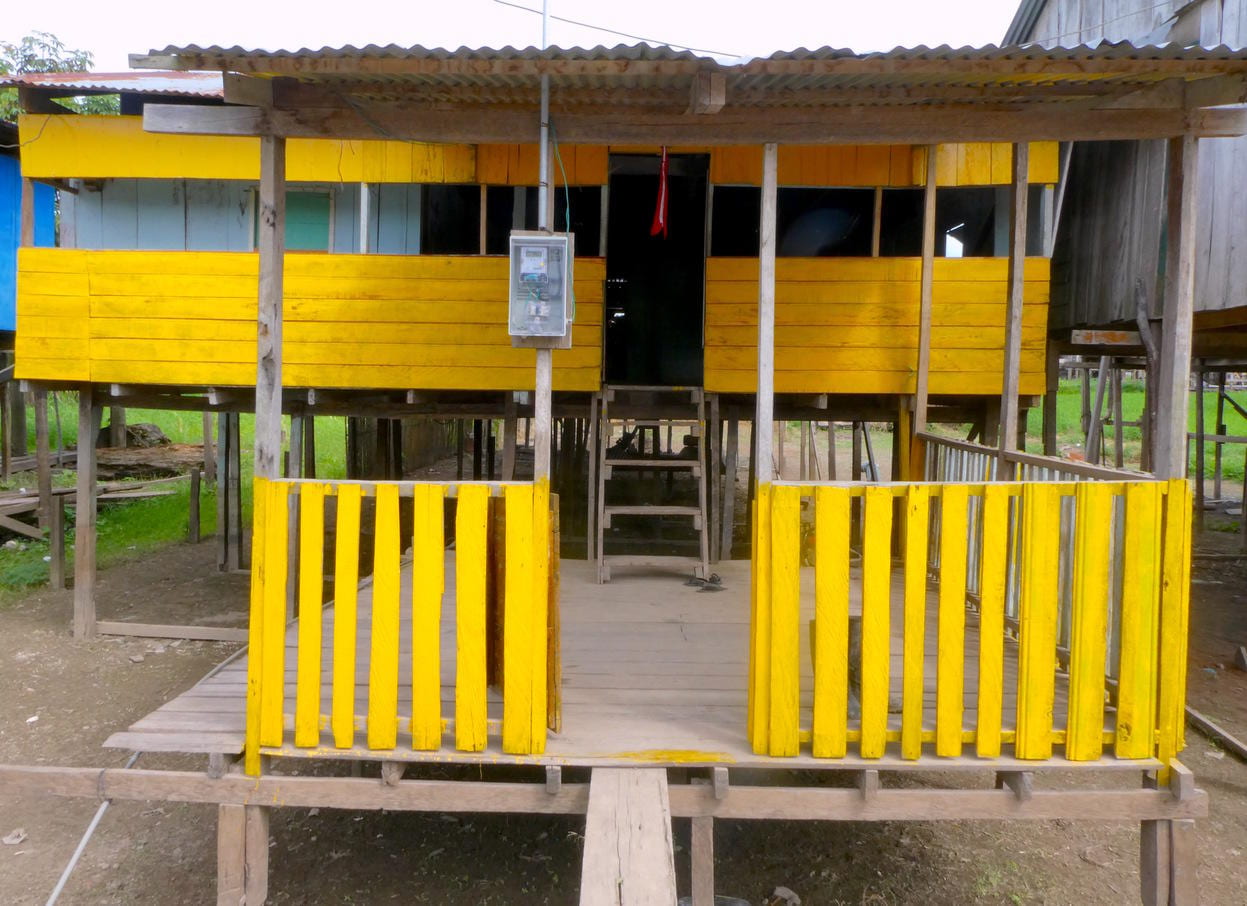
Newly installed electricity meter house built with elevation above flood line in the Peruvian Amazon.
“No contradiction,” he said.
“When one is baptized in the Catholic religion, one is Catholic,” he said. “We do speak of the Earth, of nature—but we don’t have any problem [with being Catholic], because everything is the same universe. All is complete. The jungle, the trees, all are created by God. And our Lord Jesus Christ came down to Earth to save us from our sins. That’s the way it is.”
Later, as I lay in my hammock in the darkness, I felt the way in which the big house is what the indigenous say it is, a recreation of the world, with contemplation of the sacred at its center, where William spoke. Despite the occasional croaking of nearby frogs, the maloca was at this moment a world of total silence, a gift that might be possible only in such a place, a standing rainforest.
Spring/Summer 2020, Volume XIX, Number 3
Mary Jo McConahay is an Alicia Patterson Fellow. Her latest book is The Tango War, the Struggle for the Hearts, Minds and Riches of Latin America During World War II.
Related Articles
Borderland Battles
When then-President Juan Manuel Santos signed a peace accord with one of the Western Hemisphere’s oldest guerrillas in 2016 (the Fuerzas Armadas Revolucionarias de Colombia – FARC), optimism ran high that an end to decades-long violence in Colombia had been…
Exile Music
Novels about the Holocaust and Jewish survival span countries and languages and audiences of all ages. Such stories tend to be told against a European or United States background. Rarely does a novel involve European Jewish refugees who found sanctuary in Latin…
Fluvial Poetics in the Amazon
English + Español
We were in the hands of the river. I had been told that the boat for Manaus, in the Brazilian Amazon, would depart from Santarém at noon. Instead, we set sail at 2 pm. The arrival was even more difficult to determine. The guy who sold me the tickets assured me that…

